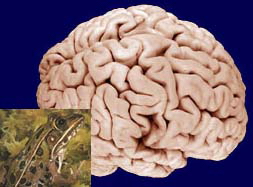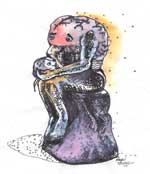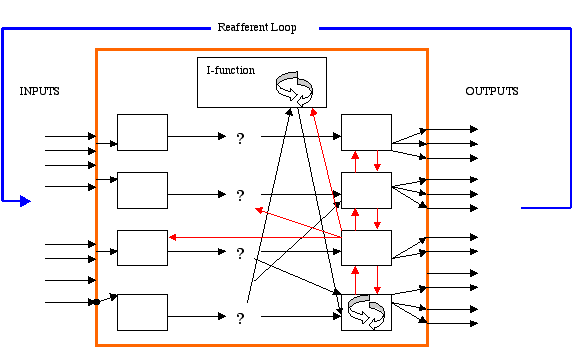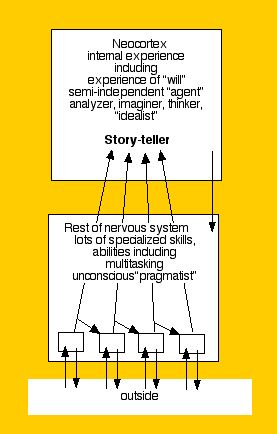Serendip is an independent site partnering with faculty at multiple colleges and universities around the world. Happy exploring!
BBI 2007 Session 11

|
|

|
BRAIN AND BEHAVIOR INSTITUTE 2007 |

|
Output Architecture, Continued
Review (and completion of output side)


- Central pattern generation, corollary discharge
- Gene/environment interaction
- Distributed control
- Influences on input
"I liked the concept of the nervous system having certain scores stored inside of it and yet at other times making thing up as it goes along... like jazz musicians" ... Cheryl
"What you're experiencing is influenced by what you're doing and by your genes-very interesting suppositions for an inquiry based educatonal setting." ... Mingh
"All symphonies have a conductor...imagine what might happen if they didn't..." ... Geneva (see also Bob and Paul)
"I liked the idea of the nervous system being explained as a symphony but I am a little concerned about what will happen if the outside stimulus is the unconscious as in the example of a sleep walker or a person who has multiple personalities. How can their symphonies be explained? How do they learn to ignore these discharges if they are not consciously aware that they are doing them?" ... Judith
Finishing up a look from the output side
- Purposive, adaptive action can occur without the "I-function"
- The cognitive unconscious and the I-function
- I-function as suppressor of existing possibilities, creator of new ones?
What particular aspect of our discussions of the motor side of the nervous system seem most useful for your classroom, for your teaching in general? Write some thoughts/questions in the institute forum area.



Comments
stories and behavior
I am going out on a limb
Monday 7/16
reflections
I function
Using the I-function
We all know that we do
Real World Situations
Monday
This mornings thoughts
motor and sensory sides of the nervous system
the power of I
The power of imaginative thinking
What really intrigues me about this morning's session is the role the I function plays in the ability to create unique and creative movements in the human body by the I function's ability to isolate, to "switch on and off" movement. I have several questions about it and wonder what implications it might have on our teaching and our students...
First, is this ability of the I function especially pronounced in those who make their life by the creative arts (dancers, figure skaters, gymnasts)? Do the brains of these people have a common variation that allows them to do this more than others?
Next, can this be extended to thinking and creativity in general? Is this something that could be applied to how a student writes or reasons?
Finally, how much of this is innate, and how much of this is learned through behavior and upbringing? Does this mean that we can teach our students to be able to isolate movement and or thought? Can our students be conditioned into being more creative, or does this mean that their brain and or muscle power is, at least to an extent, predetermined by their genetics?
Monday morning
I function
A lot has been written about the relationship between the hand and the brain implying that the strenght of the brain is positively correlated to the strength of hand control. In the classroom, we have a plethora of activities that are designed to improve the eye-hand control movement and the strength of the hand. Most of the children who enter are rudimentary in these skill areas. Furthermore, when we sing the finger play song about the fingers, most cannot isolate the individual fingers. In fact, at the beginning of the year, they seem shocked that the fingers are actually able to move separately. For my current setting, in which I only have most children for one year, I see a clear development, at the the end of the year, in their ability to isolate the individual fingers as we sing the fingerplay song. By that time, most don't even remember how hard they had to work to see that the fingers were individual digits and then try to raise each finger at the appropriate time. These same children show a clear development in their ability to self-regulate behaviors, in a variety of settings, and in their pincer grasps and eye-hand control. Furthermore, their gross motors skills are refined and executed with more finesse. The question I am leading up to is whether the strengthening of hand-eye movement and hand strength is correlated to the strengthening of the I-function. If so, what are the implications for education? A friend once described the PT she received for brain damage, due to high velocity impact, and those exercises could easily have been the same as the ones I put in my classroom for the development of hand strength and hand-eye coordination.
This issue also shows the role of awareness in mastery.
movement and I-function at early ages
I-function control
reflections
W. Keith Sgrillo Is the
W. Keith Sgrillo I feel as
Post new comment